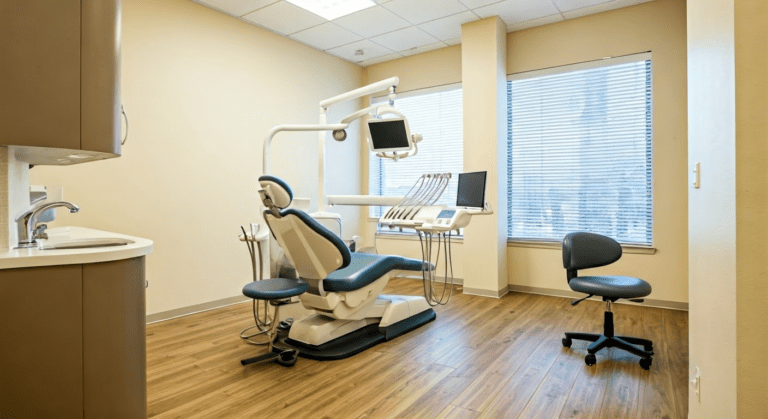How Top Dentists Manage Their Dental Scheduling Templates?
Running a dental practice isn't just about patient care—it's about managing time efficiently to maximize bookings, reduce no-shows, and keep operations running smoothly. But without a structured scheduling system, dental appointments get lost, gaps in the calendar go unfilled, and productivity suffers.
Top dentists don't leave scheduling to chance. They use optimized dental scheduling templates to streamline bookings, balance patient flow, and ensure their team works efficiently. A well-structured system eliminates double bookings, automates reminders, and minimizes last-minute cancellations, keeping revenue steady and patients happy. The secret? A scheduling template that adapts to patient demand ensures seamless coordination and improves overall efficiency. If your practice still struggles with scheduling chaos, it's time to upgrade. Let's explore how top dentists manage their appointment templates to stay productive and profitable.What Are the Components of Dental Scheduling Templates?

A well-structured dental clinic schedule template is more than just filling upcoming appointment slots—it's about optimizing time, resources, and workflow to ensure seamless operations and enhance patient experience. Here's how top-performing clinics structure their schedules for maximum efficiency.
1. Time Blocks & Units: The Backbone of Scheduling
Time is one of the most valuable assets in a dental office. Without structured time blocks, appointments can be overrun, patient flow becomes unpredictable, and efficiency suffers.
To maintain order, clinics standardize scheduling with 30-minute blocks, further broken down into 10-minute units for precision. This approach allows for:- Refined Appointment Lengths – Adjustments based on procedure complexity ensure no appointment runs over or under the necessary time.
- Smooth Transitions – Allocating buffer time for setup and breakdown, preventing back-to-back chaos.
- Managing Overlaps – Creating synchronized buffer zones that allow flexibility for minor delays without disrupting the entire schedule.For instance, if a filling procedure unexpectedly extends by 10 minutes, a well-planned buffer prevents it from delaying the next patient's check-up.
2. Room & Resource Allocation: Preventing Scheduling Conflicts
A dentist juggling multiple patients, assistants coordinating equipment, and a hygienist waiting for a free chair—scheduling can become chaotic without proper room and resource allocation.
A strong scheduling ensures:- Chair Assignments Are Clear – Each dentist works with designated chairs, avoiding double bookings.
- Staff Allocation is Mapped Out – Hygienists, assistants, and front desk staff roles are clearly defined per procedure.
- Equipment is Prepped in Advance – Tools required for each procedure are scheduled to avoid last-minute scrambling.
- Sterilization Time is Accounted For – Ensuring compliance with hygiene protocols between patients.
3. Procedure-Based Scheduling: Grouping for Efficiency
ot all procedures require the same time, attention, or setup. By categorizing treatments, dental clinics can boost efficiency and streamline daily workflow.
Here's how to Categorize Procedures in Your Schedule:| Procedure Type | Examples | Time Required |
|---|---|---|
| Complex | Root Canals, Crown Placements | 60+ minutes |
| Simple | Fillings, Cleanings | 30 minutes or less |
| Routine | Check-Ups, Consultations | 20-30 minutes |
| Emergency | Trauma Cases, Severe Pain | Varies |
- Reduce Transition Time – Keeping similar procedures back-to-back minimizes equipment changes and setup time.
- Increase Productivity – Dentists can focus on high-concentration tasks in one block and more routine tasks later.
- Ensure Emergency Availability – Having dedicated slots prevents last-minute disruptions to the schedule.
What Are Some Tips for Effective Dental Scheduling Management?
Designing a scheduling template is one thing—making it work in the real world is another. A perfect system isn’t just about neatly organized time slots; it’s about balancing productivity without turning your team into overworked robots. Let's have a look at how you can do that in the following sections.
1. Use Analytics Data from the Right Dental Software to Set Goals
Before optimizing your scheduling process, you need a clear picture of your practice's productivity and patient flow. Understanding how many appointments you handle daily, weekly, or monthly helps you set realistic production goals and fine-tune your schedule accordingly.
A dental analytics tool such as Practice Analytics by Practice by Numbers can help simplify this process by providing insights into patient trends, scheduling patterns, and gaps in appointment bookings. Instead of manually pulling reports or struggling with spreadsheets, modern software solutions can instantly show:- Appointment Frequency – How often patients book follow-ups and routine visits.
- Call Volume & Missed Appointments – Identify patients who haven't scheduled.
- Schedule Utilization – Detect open slots and optimize booking to reduce downtime.
2. Train Staff for Communication and Efficient Scheduling
A well-trained team is the backbone of an efficient dental practice. Without clear communication and a structured scheduling approach, patient bookings can fall through the cracks, gaps remain unfilled, and staff frustration builds.
Foster Clear, Professional Communication
Good communication prevents scheduling conflicts, missed bookings, and unnecessary delays. While group texts may seem like an easy fix, mixing personal and work messaging can blur boundaries and cause disorganization. Instead, use a dedicated communication platform that allows for:
- Instant team-wide updates on schedule changes or urgent openings.
- Direct messaging between staff to ensure quick coordination.
- Centralized access to appointment details without digging through scattered messages.
Streamline Appointment Confirmations
No-shows are one of the biggest revenue drains for dental practices. Manually calling patients to confirm appointments is time-consuming and often ineffective. Instead, consider an automated system that:
- Sends personalized appointment reminders via text or email with clear instructions.
- Allows patients to confirm with a simple reply, making it easy to commit.
- Alerts staff to cancellations in real-time so they can quickly fill open slots.
Implement a Quick-Fill System for Last-Minute Cancellations
Even with the best scheduling strategies, gaps will happen. A proactive approach to filling last-minute openings can turn cancellations into opportunities. Instead of waiting for patients to call, create an on-call patient list and:
- Notify patients who are looking for sooner appointments when a spot opens.
- Use urgency-based messaging—"A last-minute slot just opened! The first to reply gets the spot."
- Prioritize emergency and waitlisted patients for efficient booking.
3. Follow Block Scheduling for a More Efficient Practice
A chaotic schedule leads to overworked staff, long patient wait times, and gaps that hurt productivity. Block scheduling solves this by organizing the day into structured time slots for specific procedures, ensuring a smooth workflow and balanced workload.
By following this method, dental practices can:- Minimize stress on staff by reducing back-to-back complex procedures.
- Enhance patient flow by grouping similar treatments.
- Maximize revenue by prioritizing high-value procedures during peak hours.
| Key Aspect | What to Do | Why It Matters |
|---|---|---|
| Study the Duration of Every Procedure | Track and record appointment times for a few weeks to determine average durations. | Prevents overbooking and minimizes downtime. |
| Categorize procedures by time needed (e.g., new patient visits, fillings, root canals). | Ensures accurate time allocation for each procedure. | |
| Adjust scheduling based on staff efficiency, as different practitioners work at different paces. | Creates a realistic, well-balanced workflow. | |
| Offer Appointment Times to Patients | Provide fixed time slots instead of letting patients choose freely. | Maintains structured scheduling and prevents disruptions. |
| Prioritize long procedures in the morning and shorter ones later in the day. | Improves staff efficiency and reduces fatigue. | |
| Allow some flexibility for special cases but stick to the block schedule as much as possible. | Balances patient convenience with an optimized schedule. | |
| Set Up a Patient Scheduling Policy | Schedule longer procedures early and minor ones later in the day. | Keeps the workflow smooth and prevents burnout. |
| Overlap appointments by a few minutes to reduce gaps and keep the schedule tight. | Maximizes productivity and minimizes idle time. | |
| Assign a scheduling manager to oversee bookings and train staff. | Ensures consistency and avoids miscommunication. |
4. Optimize Scheduling with 10-Minute Appointment Intervals
Switching from 15-minute slots to 10-minute increments helps streamline scheduling, reduce downtime, and improve patient flow. Instead of scheduling at 9:00, 9:15, 9:30, setting appointments at 9:10, 9:20, 9:30 ensures better time utilization without rushing procedures.
Benefits of 10-Minute Scheduling
- Improves Workflow – Staff manage time better, ensuring smoother transitions.
- Increases Daily Appointments – More slots mean higher patient volume and revenue.
- Reduces Downtime – Eliminates unnecessary gaps between procedures.
- Enhances Patient Flexibility – More precise scheduling makes it easier for patients to book.
- Encourages Efficient Scheduling – Helps staff sequence appointments for a balanced workload.
How to Implement It
- Start with routine procedures to test efficiency.
- Optimize check-in and prep times for smoother transitions.
- Train staff to work within structured time blocks.
Message Templates to Use While Dental Scheduling
While we've covered key principles in designing a dental schedule, it's important to remember that the ideal template varies based on your practice's specific needs. Customizable templates offer flexibility, allowing you to structure your schedule according to your unique workflow. One such template that you can draft could be for reminding the appointment for both new patients as well as the old ones.
Here are two sample template messages that you may like to consider:| Patient Type | Template Message |
|---|---|
New Patients |
"Your first visit is scheduled for [appointment date] at [appointment time]. Please bring your ID and insurance card, and complete the paperwork before your appointment." |
| Existing Patients | "Your appointment is scheduled for [date] at [time]. Please confirm, reschedule, or cancel if necessary." |
Streamline Your Dental Scheduling with Practice by Numbers
Tired of scheduling chaos and last-minute gaps in your calendar? Practice by Numbers takes the guesswork out of appointment management with data-driven scheduling templates designed to maximize efficiency, reduce no-shows, and keep your practice running smoothly.
With customizable scheduling, real-time analytics, and seamless task management, you get a system that adapts to your workflow—not the other way around. Plus, automated reminders, performance tracking, and revenue insights ensure that every appointment contributes to your bottom line. Upgrade your scheduling process with Practice by Numbers and watch your productivity—and profitability—soar. Book a demo today!Conclusion
An optimized scheduling system isn't just about filling appointment slots—it's about creating a seamless, stress-free workflow for both your staff and patients. By implementing structured scheduling methods like block scheduling, 10-minute intervals, and automated reminders, your practice can reduce downtime, minimize no-shows, and maximize daily appointments.
However, note that customization is key. No two dental offices operate similarly, so your scheduling template should adapt to your specific needs. Whether it's refining appointment durations, improving patient communication, or streamlining team coordination, the right scheduling system improves efficiency, boosts revenue, and enhances patient satisfaction. A well-structured schedule doesn't just keep your clinic running—it helps your practice grow. Fine-tune your system, train your team, and watch your scheduling process become a powerful tool for success.Frequently Asked Questions
How Can I Reduce No-Shows in My Dental Practice?
Sending automated appointment reminders to patients can significantly reduce no-shows. These notifications serve as a courtesy and help keep appointments top of mind for the patients.
How Do I Create an Efficient Dental Scheduling Policy?
An effective dental scheduling policy stems from clear communication, staff training, and utilizing a customizable schedule template. Block scheduling, using 10-minute increments, and leveraging analytics can also optimize dental scheduling.
What is dental block scheduling?
Dental block scheduling is a method of managing appointments whereby you divide your day into blocks assigned to different tasks, patients, or procedure categories. This strategy maximizes productivity and reduces stress on your dental staff.
How can a dental scheduling template improve efficiency in a dental office?
A tailored dental scheduling template sets a standard, predictable pattern for office operations. It optimizes time management, ensures effective resource allocation, and streamlines patient flow, improving overall dental office efficiency.
Are there any software options available for creating dental scheduling templates?
Several software tools and platforms offer features for creating and customizing dental scheduling templates. They further facilitate automation, provide analytics, and enable efficient patient communication, thus boosting operational efficiency.




